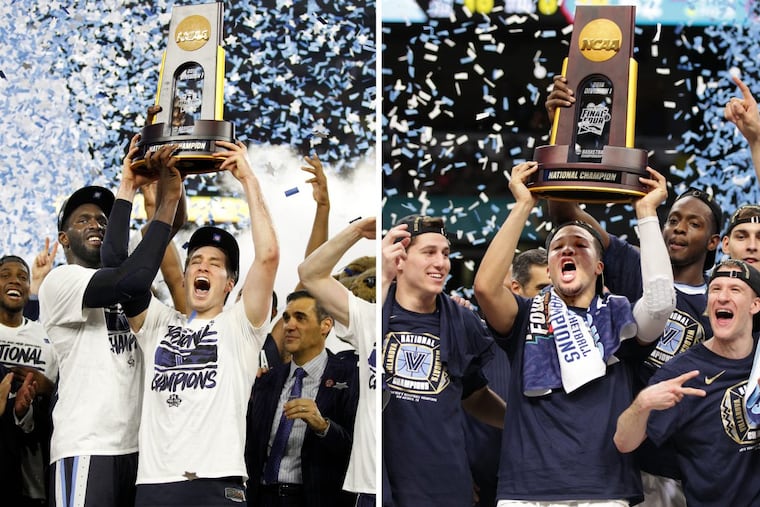Which Villanova NCAA championship team was better, 2016 or 2018? | Bob Ford
Would the present team shoot the 2016 squad off the floor? Would Ryan Arcidiacono and Josh Hart be too much to handle? Either way, it would have been a heck of a game.

The stage was quickly erected on the court after the game and the players climbed the steps and waved to the crowd. Jalen Brunson and Donte DiVincenzo and Mikal Bridges and all the stars of the Villanova team that won the national championship on Monday night were up there, and they had company as well, another group also wearing the freshly unboxed championship shirts and hats.
Ryan Arcidiacono and Kris Jenkins and Darryl Reynolds and Josh Hart were there, too, also waving to the crowd and taking turns holding the big trophy that looked just like the one back home behind glass they held two years before.
Not many college basketball programs have had two championship seasons that hold hands like the 2015-16 Villanova run and the 2017-18 title spree that ended on Monday in San Antonio.
In the era of the 64-team main bracket for the NCAA tournament, there were back-to-back championships for Duke in 1991 and 1992, and for Florida in 2006 and 2007, and a similar two-in-three-years set of titles for Kentucky in 1996 and 1998, but that's it. Before that, you have to go back to the start of the UCLA streak more than 50 years ago to find another school that was able to repeat its success with some of the same players.
That made it unique and a little eerie to see the players from the previous team, still so young and so fresh off their own title, joining this next half-generation as the streamers fell and the music played.
It was more than just the celebration, too. In 2016, DiVincenzo was a redshirt, but he played on the scout team in practice during the tournament, imitating whoever was the best shooter on the upcoming opponent. This year, Jenkins practiced with the Wildcats, mimicking some other burly forward with a good shooting touch.
"Those older guys taught this team to be Villanova basketball players," coach Jay Wright said. "We always tell the players to play for the ones who came before us, and now those are the guys who came before us. And the older guys know that these guys are playing for them. To have those guys up there with us, that's real important to us."
So, OK, just for laughs, which team would win if the two championship teams could play each other? Could freshman Jalen Brunson have guarded junior Jalen Brunson? Could Omari Spellman have handled the low post presence of Daniel Ochefu? Who was going to guard Jenkins on the wing and still account for his ability to bust to the rim? Would the scintillating, record-breaking offense of the 2018 team be just as explosive against the more formidable defense from 2016?
"This team is a lot more talented, a lot better," Arcidiacono said of the new champions. "It's a lot more capable of scoring the basketball than we were."
The stats back him up, even if he is being a little gracious. The 2016 team averaged 78 points per game. The 2018 team scored nearly 87 points per game. The first champions had four players average double-digit points. The present ones have six that averaged 10 points or more over the season.
"It's tough to compare," said Phil Booth, who played for both teams and in both championship games. "That was an older, different team. I would say this team is a lot more talented offensively, but in terms of being connected and together on defense, they might have us by a little bit, but our athleticism covers up for a lot of mistakes. That team didn't have that. They were solid and strong and didn't gamble, while this team might mess up a little bit, but then you have 6-foot-7 Mikal flying around, and 6-8 Eric Paschall flying around making up for it. Talent-wise, this team has it."
The current team is also a reflection of the direction of the Big East conference, which is increasingly predicated on high-octane offense. This year's team allowed 70.4 points per game, while the 2016 championship team allowed 63.3 points per game. That means both teams enjoyed an average winning margin of 15 or 16 points per game, but the final scores were a little higher this time around.
"The biggest difference between the teams was that Omari is a big man who is also a three-point shooter, and Daniel was a low post player. Both of those guys had unbelievable tournaments and played major roles in getting us to this point," assistant coach Ashley Howard said.
The question of which player would have had a matchup advantage – the rangy red-shirt freshman or the rock-solid senior – makes for an interesting debate, but it is no more answerable than the theoretical final score.
"The 2016 team was a real businesslike bunch of veterans. Everybody had his role and we were good all year long," Wright said. "This team, with young guys, just kept getting better. We had a lot more doubts about this team than the other team. This team, defensively, until maybe two-thirds of the way through the year, was scary."
It settled down, though, and played the kind of defense a team needs to find its way to the end of the NCAA tournament. By the end, it could stand side-by-side with the 2016 team in every way. In fact, the current players did stand side-by-side with those guys, all up there together on the platform that rose from the court like an overlook from which they could gaze back and see the road that got them there. Forget asking which team was better. They were both better than everyone else.